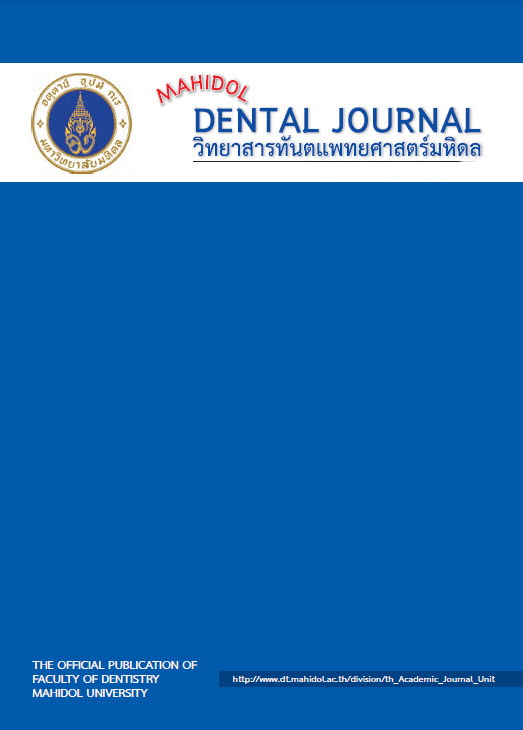The effect of staining solutions on the color stability of the provisional restorative materials
Main Article Content
Abstract
Objective: To investigate color stability of four provisional restorative materials after immersion in different staining solutions at various immersion time.
Materials and methods: Four provisional restorative materials were selected, namely, methacrylate resin (Unifast Trad) and bis-acryl resins (Protemp 4, Luxatemp Fluorescence and Integrity). Twenty-one disc shaped specimens (15 mm diameter, 1 mm thick) were prepared from each provisional restorative materials according to the manufacturer’s instruction. Seven specimens of each material were randomly assigned for immersion in distilled water (control), coffee and curry. All specimens were stored in the solutions at 37°C. According to CIELAB system, the color baseline was measured with the spectrophotometer. The color change (∆E) was measured after immersion for 7, 30 and 90 days. Data were analyzed statistically with two-way repeated analysis of variance and multiple comparisons.
Results: Distilled water (control): All provisional restorative materials had no statistically significant difference in mean color change at day 7 (p>0.05). At day 30, color change of Unifast Trad (∆E30=1.5±0.18) was significantly higher than Luxatemp (∆E30= 0.80±0.52) (p<0.05). At day 90, Unifast Trad (∆E90= 3.58±0.29) showed significantly higher color change than others (p<0.05). Coffee: All provisional restorative materials had no statistically significant difference in color change at day 7 and 90 (p>0.05), except Integrity (∆E7= 11.93±4.69), (∆E90= 21.80±3.88) which had significantly higher color change (p<0.05). At day 30, Integrity (∆E30= 15.81±4.17) showed significantly higher color change than Luxatemp (∆E30= 11.53±2.91) and Unifast Trad (∆E30= 10.39±1.10) (p<0.05). Curry: All provisional restorative materials had no statistically significant difference in color change at day 7 and 30, except Unifast Trad (∆E7=6.14±0.98), (∆E30=9.32±3.17) which had significantly lower color change (p<0.05). At day 90, Unifast Trad (∆E90=24.41±3.37) showed significantly lower color change than others (p<0.05).
Conclusion: The type of provisional restorative materials, staining solutions and immersion time could affect the color stability of provisional restorative materials.
Article Details
References
fundamentals of fixed prosthodontics. Chicogo: Quintessence; 1997.
2. Christensen GJ. The fastest and best provisional restorations. J Am Dent Assoc 2003; 134: 637-39.
3. Gough M. A review of temporary crowns and bridges. Dent Update 1994; 21: 203-07.
4. Watanabe H, Kim E, Piskorski NL, Sarsland J, Covey DA, Johnson WW. Mechanical properties and color stability of provisional restoration resins. Am J Dent 2013; 26: 265-70.
5. Bayindir F, Kurklu D, Yanikoglu ND. The effect of staining solutions on the color stability of provisional prosthodontic materials. J Dent 2012; 40: 41-46.
6. Scotti R, Mascellani SC, Forniti F. The in vitro color stability of acrylic resins for provisional restorations. Int J Prosthodont 1997; 10: 164-68.
7. Doray PG, Li D, Powers JM. Color stability of provisional restorative materials after accelerated aging. J Prosthodont 2001; 10: 212-16.
8. Turgut S, Bagis B, Ayaz EA, Ulusoy KU, Altintas SH, Korkmaz FM, et al. Discoloration of provisional restorations after oral rinses. Int J Med Sci 2013; 10: 1503-09.
9. Tekce N, Tuncer S, Demirci M, Serim ME, Baydemir C. The effect of different drinks on the color stability of different restorative materials after one month. Restor Dent Endod 2015; 40: 255-61.
10. Haselton DR, Diaz-Arnold AM, Dawson DV. Color stability of provisional crown and fixed partial denture resins. J Prosthet Dent 2005; 93: 70-75.
11. Sham AS, Chu FC, Chai J, Chow TW. Color stability of provisional prosthodontic materials. J Prosthet Dent 2004; 91: 447-52.
12. CIE. Technical report : colorimeter commission internationale de l'eclairage CIE 15 3rd editions. Vienna : Bureau Central de la CIE2004.
13. Johnston WM, Kao EC. Assessment of appearance match by visual observation and clinical colorimetry. J Dent Res 1989; 68: 819-22.
14. Bravo L. Poly-phenols: chemistry, dietary sources, metabolism, and nutritional significance. Nutr Rev 1998; 56: 317-33.
15. Borges AL, Costa AK, Saavedra GS, Komori PC, Borges AB, Rode SM. Color stability of composites: effect of immersion media. Acta Odontol Latinoam 2011; 24: 193-99.
16. Erdemir U, Yildiz E, Eren MM. Effects of sports drinks on color stability of nanofilled and microhybrid composites after long-term immersion. J Dent 2012; 40: 55-63.
17. Malekipour MR, Sharafi A, Kazemi S, Khazaei S, Shirani F. Comparison of color stability of a composite resin in different color media. Dent Res J (Isfahan) 2012; 9: 441-46.
18. Maalhagh-Fard A, Wagner WC, Pink FE, Neme AM. Evaluation of surface finish and polish of eight provisional restorative materials using acrylic bur and abrasive disk with and without pumice. Oper Dent 2003; 28: 734-39.
19. Crispin BJ, Caputo AA. Color stability of temporary restorative materials. J Prosthet Dent 1979; 42: 27-33.
20. Haselton DR, Diaz-Arnold AM, Dawson DV. Effect of storage solution on surface roughness of provisional crown and fixed partial denture materials. J Prosthodont 2004; 13: 227-32.
21. Yannikakis SA, Zissis AJ, Polyzois GL, Caroni C. Color stability of provisional resin restorative materials. J Prosthet Dent 1998; 80: 533-39.
22. Kerby RE, Knobloch LA, Sharples S, Peregrina A. Mechanical properties of urethane and bis-acryl interim resin materials. J Prosthet Dent 2013; 110: 21-28.

